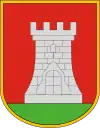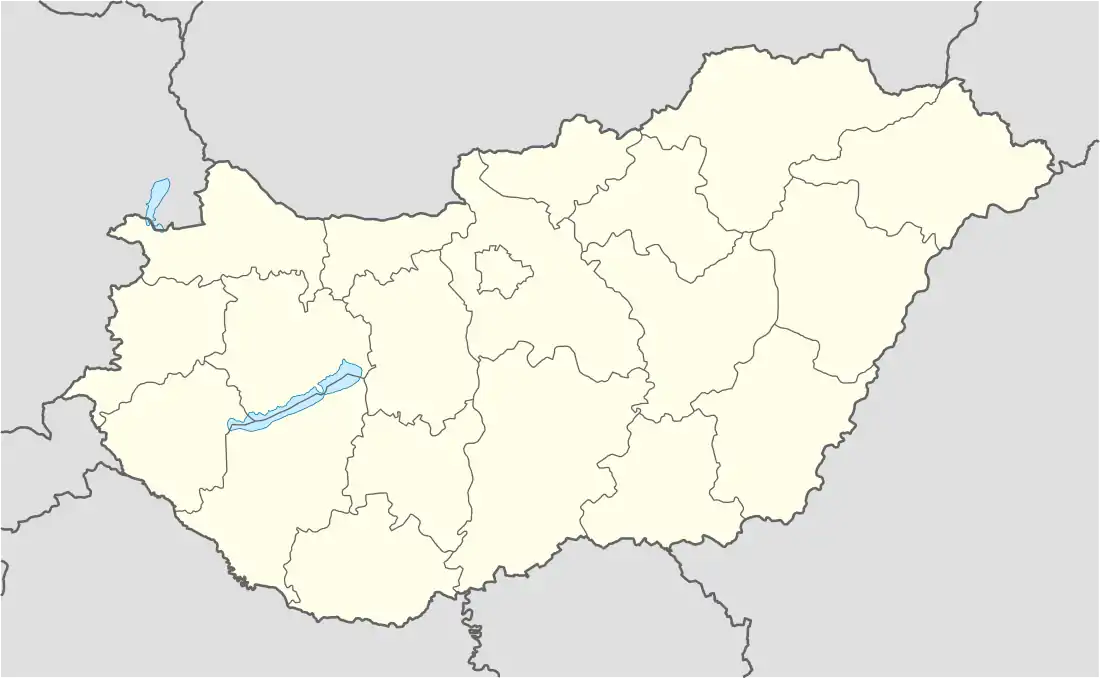Sárvár
Sárvár (German: Kotenburg, Rotenturm an der Raab, Slovene: Mala Sela) is a town in Hungary in Vas.
Sárvár
Bassiana (in Latin) Kotenburg / Rotenturm an der Raab (in German) Mala Sela (in Slovene) | |
|---|---|
 | |
 Flag  Coat of arms | |
 Sárvár Location of Sárvár | |
| Coordinates: 47.25415°N 16.93545°E | |
| Country | |
| County | Vas |
| District | Sárvár |
| Area | |
| • Total | 64.64 km2 (24.96 sq mi) |
| Population | |
| • Total | 15,226[1] |
| • Density | 242/km2 (630/sq mi) |
| Time zone | UTC+1 (CET) |
| • Summer (DST) | UTC+2 (CEST) |
| Postal code | 9600, 9609 |
| Area code | (+36) 95 |
| Website | www |

Etymology
Sár means "mud" in Hungarian, and vár means "castle". The latter is a common ending for settlement names.
Castle
Through the Nádasdy family, the castle of Sárvár, now called Nádasdy Castle, played a significant role in the progress of Hungarian culture in the 16th and 17th centuries. The first Hungarian book, The New Testament of 1541, was printed here. The knight's hall of the castle is decorated with the battle scenes of Lord Chief Justice Ferenc Nádasdy (married to the notorious Elizabeth Báthory) and with scenes from the Old Testament.
The Nádasdy Castle and estate later became a property of the kings of Bavaria, and the former King Ludwig III died there in 1921, three years after being deposed.[2] During the Second World War, the castle was used as the retreat of Ludwig's grandson Prince Albert of Bavaria.
Town
The population of the town lying on the banks of the River Rába at Kemeneshát is nearly 16,000. The town has become a tourist centre of international renown.
The most outstanding sights include: the arboretum (a nature reserve), the neo-Classical Lutheran church and the Roman Catholic church, the park forest and the Csónakázó (= Rowing) Lake. A new Thermal and Wellness bath of European standard was opened in 2002 awaiting visitors in pleasant surroundings.
Sárvár's notable sights include the spa (with its famous medicinal water), a Baroque church, and an arboretum. A number of rarities of cultural remains are shown in the exhibition halls of the Ferenc Nádasdy Museum.
In 1564 András Beythe (botanist) was born in Sárvár.
During the Second World War, Sárvár was used as a centre for the internment for Polish soldiers who had arrived in Hungary in 1939. Later, during the Second World War, Sárvár was used as a concentration camp for the internment for thousands of Serb families expelled by Hungarian soldiers from their homes in northern Serbia in 1941.[3] Now, there is a monument and graveyard for hundreds of Serbs who died in Sárvár concentration camp.[4]
People from Sárvár
- Hungarian football player Péter Balassa,
- Holocaust survivor and artist Alice Lok Cahana,
- Prof Edward Eisner FRSE Professor of Applied Physics at the University of Strathclyde
- politician József Vass,
- Olympian hammer thrower József Vida,
- Takács de Saár, Hungarian noble family
- Football player Zoltán Stieber
British avian flu outbreak
The Bernard Matthews Sága Foods plant in Sárvár, that processes turkeys, has been implicated in the H5N1 outbreak in Suffolk, England.[5]
Twin towns – sister cities
Sárvár is twinned with:
 Seini, Romania
Seini, Romania Sonntagberg, Austria
Sonntagberg, Austria Steinheim an der Murr, Germany
Steinheim an der Murr, Germany Uherské Hradiště, Czech Republic
Uherské Hradiště, Czech Republic
References
- Sárvár, KSH
- Encyclopædia Britannica: a new survey of universal knowledge, vol. 14 (1961), p. 413
- http://www.politika.rs/sr/clanak/345274/Susret-prezivelih-logorasa-Sarvara
- http://www.politika.rs/sr/clanak/345274/Susret-prezivelih-logorasa-Sarvara
- "Bird flu plant imported turkey from Hungary", Charles Clover, The Daily Telegraph, 9 February 2007
External links
| Wikimedia Commons has media related to Sárvár. |
- Official website in Hungarian, English, German and Czech
- Accommodation in Sárvár

